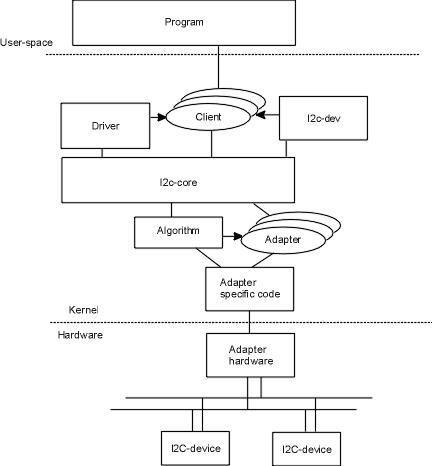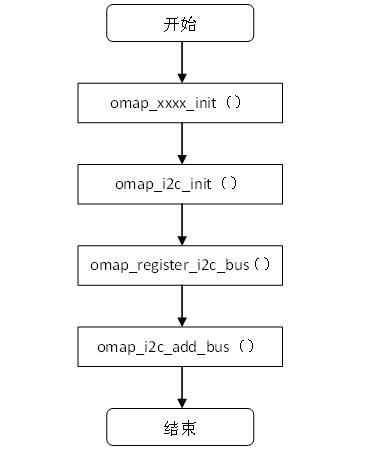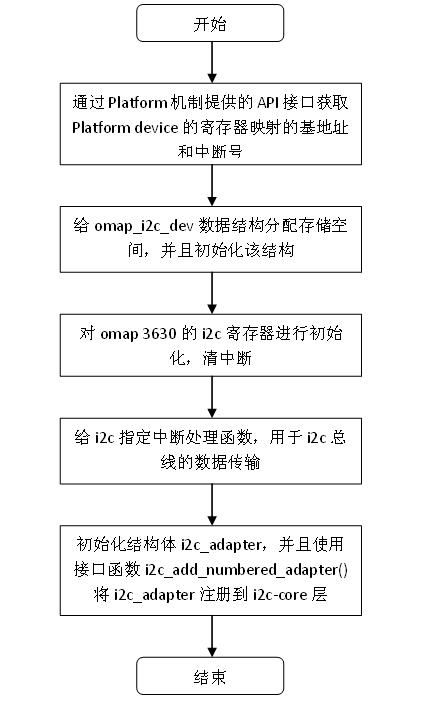OMAP3630 Linux I2C总线驱动分析
1 Linux I2C驱动架构
Linux下I2C驱动的架构图如下:
如上图所示,每条I2C总线会对应一个adapter,而每条I2C总线上则可以有多个 client,在linux kernel中,通过I2C core层将I2C client与I2C adapter关联起来,Linux 中I2C驱动代码位于drivers/i2c目录。
Linux中I2C可以分为三个层次,分别为I2C core层、I2C adapter driver层、I2C device driver层。
1.1 I2C core层
I2C core是用于维护Linux的I2C核心部分,提供了核心的数据结构,I2C适配器驱动和设备驱动的注册、注销管理等API,同时还提供了I2C总线读写访问的一般接口(具体的实现在与I2C控制器相关的I2C adapter中实现)。
该层为硬件平台无关层,向下屏蔽了物理总线适配器的差异,定义了统一的访问策略和接口;向上则提供了统一的接口,以便I2C设备驱动可以通过总线适配器进行数据收发。
Linux中,I2C core层的代码位于driver/i2c/ i2c-core.c。由于该层是平台无关层,本文将不再叙述,有兴趣可以查阅相关资料。
1.2 I2C adapter driver层
I2C adapter driver层即I2C适配器驱动层,每种处理器平台都有自己的适配器驱动,属于平台移植相关层。它的职责是为系统中每条I2C总线实现相应的读写方法。但是适配器驱动本身并不会进行任何的通讯,而是等待设备驱动调用其函数。
在系统开机时,I2C适配器驱动被首先装载。一个适配器驱动用于支持一条特定的I2C总线的读写。一个适配器驱动通常需要两个模块,一个struct i2c_adapter和一个struct i2c_algorithm来描述。
i2c adapter 构造一个对I2C core层接口的数据结构,并通过相应的接口函数向I2C core注册一个适配器。i2c_algorithm主要实现对I2C总线访问的算法,master_xfer和smbus_xfer即I2C adapter底层对I2C总线读写方法的实现,相关的数据结构如下:
- /*
- * The following structs are for those who like to implement new bus drivers:
- * i2c_algorithm is the interface to a class of hardware solutions which can
- * be addressed using the same bus algorithms - i.e. bit-banging or the PCF8584
- * to name two of the most common.
- */
- struct i2c_algorithm {
- /* If an adapter algorithm can't do I2C-level access, set master_xfer
- to NULL. If an adapter algorithm can do SMBus access, set
- smbus_xfer. If set to NULL, the SMBus protocol is simulated
- using common I2C messages */
- /* master_xfer should return the number of messages successfully
- processed, or a negative value on error */
- int (*master_xfer)(struct i2c_adapter *adap, struct i2c_msg *msgs,
- int num);
- int (*smbus_xfer) (struct i2c_adapter *adap, u16 addr,
- unsigned short flags, char read_write,
- u8 command, int size, union i2c_smbus_data *data);
- /* To determine what the adapter supports */
- u32 (*functionality) (struct i2c_adapter *);
- };
主要就是master_xfer方法,其和具体的总线控制器相关,不同的CPU在实现上会有差异。
- /*
- * i2c_adapter is the structure used to identify a physical i2c bus along
- * with the access algorithms necessary to access it.
- */
- struct i2c_adapter {
- struct module *owner;
- unsigned int id;
- unsigned int class; /* classes to allow probing for */
- const struct i2c_algorithm *algo; /* the algorithm to access the bus */
- void *algo_data;
- /* data fields that are valid for all devices */
- struct rt_mutex bus_lock;
- int timeout; /* in jiffies */
- int retries;
- struct device dev; /* the adapter device */
- int nr;
- char name[48];
- struct completion dev_released;
- struct list_head userspace_clients;
- };
Algo是和底层硬件的接口,标识了具体的物理总线传输的实现。
Userspace_clients为使用该总线的client链表。
Nr为该适配器也就是某条I2C总线占据的全局编号。
bus_lock总线的互斥锁,防止总线冲突。
Linux中,I2C adapter driver层的代码位于drivers/i2c/busses目录,第3章会详细介绍该层的内容。
1.3 I2C device driver层
I2C device driver层为用户接口层,其为用户提供了通过I2C总线访问具体设备的接口。
I2C的device driver层可以用两个模块来描述,struct i2c_driver和struct i2c_client。
i2c_client和i2c_driver分别构造对I2C core层接口的数据结构,并且通过相关的接口函数向 I2C Core注册I2C设备驱动。相关的数据结构如下:
- /**
- * struct i2c_driver - represent an I2C device driver
- * @class: What kind of i2c device we instantiate (for detect)
- * @attach_adapter: Callback for bus addition (for legacy drivers)
- * @detach_adapter: Callback for bus removal (for legacy drivers)
- * @probe: Callback for device binding
- * @remove: Callback for device unbinding
- * @shutdown: Callback for device shutdown
- * @suspend: Callback for device suspend
- * @resume: Callback for device resume
- * @command: Callback for bus-wide signaling (optional)
- * @driver: Device driver model driver
- * @id_table: List of I2C devices supported by this driver
- * @detect: Callback for device detection
- * @address_list: The I2C addresses to probe (for detect)
- * @clients: List of detected clients we created (for i2c-core use only)
- *
- * The driver.owner field should be set to the module owner of this driver.
- * The driver.name field should be set to the name of this driver.
- *
- * For automatic device detection, both @detect and @address_data must
- * be defined. @class should also be set, otherwise only devices forced
- * with module parameters will be created. The detect function must
- * fill at least the name field of the i2c_board_info structure it is
- * handed upon successful detection, and possibly also the flags field.
- *
- * If @detect is missing, the driver will still work fine for enumerated
- * devices. Detected devices simply won't be supported. This is expected
- * for the many I2C/SMBus devices which can't be detected reliably, and
- * the ones which can always be enumerated in practice.
- *
- * The i2c_client structure which is handed to the @detect callback is
- * not a real i2c_client. It is initialized just enough so that you can
- * call i2c_smbus_read_byte_data and friends on it. Don't do anything
- * else with it. In particular, calling dev_dbg and friends on it is
- * not allowed.
- */
- struct i2c_driver {
- unsigned int class;
- /* Notifies the driver that a new bus has appeared or is about to be
- * removed. You should avoid using this if you can, it will probably
- * be removed in a near future.
- */
- int (*attach_adapter)(struct i2c_adapter *);
- int (*detach_adapter)(struct i2c_adapter *);
- /* Standard driver model interfaces */
- int (*probe)(struct i2c_client *, const struct i2c_device_id *);
- int (*remove)(struct i2c_client *);
- /* driver model interfaces that don't relate to enumeration */
- void (*shutdown)(struct i2c_client *);
- int (*suspend)(struct i2c_client *, pm_message_t mesg);
- int (*resume)(struct i2c_client *);
- /* Alert callback, for example for the SMBus alert protocol.
- * The format and meaning of the data value depends on the protocol.
- * For the SMBus alert protocol, there is a single bit of data passed
- * as the alert response's low bit ("event flag").
- */
- void (*alert)(struct i2c_client *, unsigned int data);
- /* a ioctl like command that can be used to perform specific functions
- * with the device.
- */
- int (*command)(struct i2c_client *client, unsigned int cmd, void *arg);
- struct device_driver driver;
- const struct i2c_device_id *id_table;
- /* Device detection callback for automatic device creation */
- int (*detect)(struct i2c_client *, struct i2c_board_info *);
- const unsigned short *address_list;
- struct list_head clients;
- };
Driver是为device服务的,i2c_driver注册时会扫描i2c bus上的设备,进行驱动和设备的绑定。主要有两种接口attach_adapter和probe,二者分别针对旧的和新式的驱动。
- /**
- * struct i2c_client - represent an I2C slave device
- * @flags: I2C_CLIENT_TEN indicates the device uses a ten bit chip address;
- * I2C_CLIENT_PEC indicates it uses SMBus Packet Error Checking
- * @addr: Address used on the I2C bus connected to the parent adapter.
- * @name: Indicates the type of the device, usually a chip name that's
- * generic enough to hide second-sourcing and compatible revisions.
- * @adapter: manages the bus segment hosting this I2C device
- * @driver: device's driver, hence pointer to access routines
- * @dev: Driver model device node for the slave.
- * @irq: indicates the IRQ generated by this device (if any)
- * @detected: member of an i2c_driver.clients list or i2c-core's
- * userspace_devices list
- *
- * An i2c_client identifies a single device (i.e. chip) connected to an
- * i2c bus. The behaviour exposed to Linux is defined by the driver
- * managing the device.
- */
- struct i2c_client {
- unsigned short flags; /* div., see below */
- unsigned short addr; /* chip address - NOTE: 7bit */
- /* addresses are stored in the */
- /* _LOWER_ 7 bits */
- char name[I2C_NAME_SIZE];
- struct i2c_adapter *adapter; /* the adapter we sit on */
- struct i2c_driver *driver; /* and our access routines */
- struct device dev; /* the device structure */
- int irq; /* irq issued by device */
- struct list_head detected;
- };
通常来说i2c_client对应着I2C总线上某个特定的slave或者是user space的某个用户对应,而此时的slave可以动态变化。
Linux中,I2C device driver层的代码位于drivers/i2c/chips目录,第4章将详细介绍该层的内容。
2 OMAP3630 I2C控制器
OMAP3630具有4个高速I2C控制器,每个控制器都通过I2C串行总线为本地主机即OAMP3630 MPU和I2C总线兼容设备提供了一个通讯接口,支持多达8-bit的数据传送和接收。
每个I2C控制器都能配置成一个主机或者从机设备,而且他们都能配置成在一个2线的串行的摄像头控制总线(SCCB总线)上作为主设备,I2C2和I2C3还能配置成在一个3线的SCCB总线上作为主设备。
I2C4控制器位于PRCM模块,可以进行动态电压控制和电源序列测定。
OMAP3630的I2C控制器模块图如下:
图2.1 OMAP3630 I2C控制器模块图
控制器1,2,3具有以下特征:
兼容飞利浦I2C 2.1版本
支持标准I2C标准模式(100Kbps)和快速模式(400Kpbs)
支持高达3.4Mbps的高速发送模式
支持I2C2和I2C3 模块的3线/2线的SCCB主从模式,I2C1 模块的2线的SCCB主从模式,高达100kbit/s
7-bit和10bit的设备地址模式
多主控发送/从接收模式
多主控接收/从发送模式
联合的主机发送/接收和接收/发送模式
内置FIFO(8,16,32,64字节大小)用于缓存读取和接收
模块使能/关闭
可编程的时钟
8-bit的数据存取
低功耗的设计
两个DMA通道
支持中断机制
自动空闲机制
空闲请求和应答握手机制
主从的发送机I2C4控制器有以下特征:
支持高速和快速模式
只能支持7-bit地址模式
只支持主发送模式
关于I2C控制器的详细介绍请参考OMAP36XX_ES1.1_NDA_TRM_V_G.pdf的第17章。
3 OMAP3630 I2C adapter驱动
在Linux内核中,I2C adapter驱动位于drivers/i2c/busses目录下,OMAP3630 的I2C adapter驱动程序为i2c-omap.c。
I2C adapter驱动,本质上就是实现了具体的总线传输算法并向核心层注册适配器。该驱动的注册采用Platform驱动和设备机制。
3.1 I2C adapter的Platform device
Andrord 2.1中Platform device的注册的代码位于内核的arch/arm/plat-omap/i2c.c,arch/arm/mach-omap2/board-xxxx.c中。
3.1.1 Platform device的定义
在文件arch/arm/plat-omap/i2c.c中,Platform device定义如下:
- #define OMAP_I2C_SIZE 0x3f
- #define OMAP1_I2C_BASE 0xfffb3800
- #define OMAP2_I2C_BASE1 0x48070000
- #define OMAP2_I2C_BASE2 0x48072000
- #define OMAP2_I2C_BASE3 0x48060000
- static const char name[] = "i2c_omap";
- #define I2C_RESOURCE_BUILDER(base, irq) /
- { /
- .start = (base), /
- .end = (base) + OMAP_I2C_SIZE, /
- .flags = IORESOURCE_MEM, /
- }, /
- { /
- .start = (irq), /
- .flags = IORESOURCE_IRQ, /
- },
- static struct resource i2c_resources[][2] = {
- { I2C_RESOURCE_BUILDER(0, 0) },
- #if defined(CONFIG_ARCH_OMAP24XX) || defined(CONFIG_ARCH_OMAP34XX)
- { I2C_RESOURCE_BUILDER(OMAP2_I2C_BASE2, INT_24XX_I2C2_IRQ) },
- #endif
- #if defined(CONFIG_ARCH_OMAP34XX)
- { I2C_RESOURCE_BUILDER(OMAP2_I2C_BASE3, INT_34XX_I2C3_IRQ) },
- #endif
- };
- #define I2C_DEV_BUILDER(bus_id, res, data) /
- { /
- .id = (bus_id), /
- .name = name, /
- .num_resources = ARRAY_SIZE(res), /
- .resource = (res), /
- .dev = { /
- .platform_data = (data), /
- }, /
- }
- static u32 i2c_rate[ARRAY_SIZE(i2c_resources)];
- static struct platform_device omap_i2c_devices[] = {
- I2C_DEV_BUILDER(1, i2c_resources[0], &i2c_rate[0]),
- #if defined(CONFIG_ARCH_OMAP24XX) || defined(CONFIG_ARCH_OMAP34XX)
- I2C_DEV_BUILDER(2, i2c_resources[1], &i2c_rate[1]),
- #endif
- #if defined(CONFIG_ARCH_OMAP34XX)
- I2C_DEV_BUILDER(3, i2c_resources[2], &i2c_rate[2]),
- #endif
- };
可以看到,这边定义了三个I2C适配器的Platform device,id分别为“1,2,3”,name都为“i2c_omap”,变量resource中定义了适配器的寄存器基地址,irq中断号等。
3.1.2 Platform device的注册
Platform device的注册是由内核启动后,具体产品的板级初始化完成的。xxxx项目的I2C adapter的Platform device注册过程如下图:
图3.1 Platform device注册过程
函数omap_i2c_add_bus()中,通过函数platform_device_register()注册Platform device到platform bus上,代码如下:
- static int __init omap_i2c_add_bus(int bus_id)
- {
- struct platform_device *pdev;
- struct resource *res;
- resource_size_t base, irq;
- ……
- ……
- return platform_device_register(pdev);
- }
注册完成后,中断号及寄存器的基地址等信息会在设备树中描述了,此后只需利用platform_get_resource等标准接口自动获取即可,实现了驱动和资源的分离。
3.2 I2C adapter的Platform driver
Andrord 2.1中Platform driver的注册的代码位于内核的drivers/i2c/busses/ i2c-omap.c中,该驱动的注册目的是初始化OMAP3630的I2C adapter,提供I2C总线传输的具体实现,并且向I2C core注册I2C adapter。
3.2.1 Platform driver的定义
在文件drivers/i2c/busses/ i2c-omap.c中,platform driver定义如下:
- static struct platform_driver omap_i2c_driver = {
- .probe = omap_i2c_probe,
- .remove = omap_i2c_remove,
- .driver = {
- .name = "i2c_omap",
- .owner = THIS_MODULE,
- },
- };
3.2.2 Platform driver的注册
在文件drivers/i2c/busses/ i2c-omap.c中,platform driver注册如下:
- /* I2C may be needed to bring up other drivers */
- static int __init
- omap_i2c_init_driver(void)
- {
- return platform_driver_register(&omap_i2c_driver);
- }
- subsys_initcall(omap_i2c_init_driver);
通过platform_driver_register()函数注册Platform driver omap_i2c_driver时,会扫描platform bus上的所有设备,由于匹配因子是name即"i2c_omap",而之前已经将name为"i2c_omap"的Platform device注册到platform bus上,因此匹配成功,调用函数omap_i2c_probe将设备和驱动绑定起来。
在drivers/i2c/busses/ i2c-omap.c中会涉及到一个数据结构omap_i2c_dev,这个结构定义了omap3630的I2C控制器,结构如下:
- struct omap_i2c_dev {
- struct device *dev;
- void __iomem *base; /* virtual */
- int irq;
- struct clk *iclk; /* Interface clock */
- struct clk *fclk; /* Functional clock */
- struct completion cmd_complete;
- struct resource *ioarea;
- u32 speed; /* Speed of bus in Khz */
- u16 cmd_err;
- u8 *buf;
- size_t buf_len;
- struct i2c_adapter adapter;
- u8 fifo_size; /* use as flag and value
- * fifo_size==0 implies no fifo
- * if set, should be trsh+1
- */
- u8 rev;
- unsigned b_hw:1; /* bad h/w fixes */
- unsigned idle:1;
- u16 iestate; /* Saved interrupt register */
- u16 pscstate;
- u16 scllstate;
- u16 sclhstate;
- u16 bufstate;
- u16 syscstate;
- u16 westate;
- };
Base对应I2C控制器寄存器的虚拟地址。
Irq对应I2C控制器的中断号。
Buf对应上层传下来的需要发送数据或者I2C控制接收到数据的缓存空间,buf_len是其大小。
Adapter对应I2C控制器的适配器结构。
U16类型的各个state变量是用于对应I2C控制器的寄存器的值。
函数omap_i2c_probe的执行流程如下图:
图3.2 omap_i2c_probe的执行流程
函数omap_i2c_probe的简要代码如下:
- static int __init
- omap_i2c_probe(struct platform_device *pdev)
- {
- struct omap_i2c_dev *dev;
- struct i2c_adapter *adap;
- struct resource *mem, *irq, *ioarea;
- irq_handler_t isr;
- ……
- /* NOTE: driver uses the static register mapping */
- mem = platform_get_resource(pdev, IORESOURCE_MEM, 0);
- ……
- irq = platform_get_resource(pdev, IORESOURCE_IRQ, 0);
- ……
- dev = kzalloc(sizeof(struct omap_i2c_dev), GFP_KERNEL);
- ……
- dev->dev = &pdev->dev;
- dev->irq = irq->start;
- dev->base = ioremap(mem->start, mem->end - mem->start + 1);
- ……
- /* reset ASAP, clearing any IRQs */
- omap_i2c_init(dev);
- isr = (dev->rev < OMAP_I2C_REV_2) ? omap_i2c_rev1_isr : omap_i2c_isr;
- r = request_irq(dev->irq, isr, 0, pdev->name, dev);
- ……
- adap = &dev->adapter;
- i2c_set_adapdata(adap, dev);
- adap->owner = THIS_MODULE;
- adap->class = I2C_CLASS_HWMON;
- strncpy(adap->name, "OMAP I2C adapter", sizeof(adap->name));
- adap->algo = &omap_i2c_algo;
- adap->dev.parent = &pdev->dev;
- /* i2c device drivers may be active on return from add_adapter() */
- adap->nr = pdev->id;
- r = i2c_add_numbered_adapter(adap);
- ……
- return 0;
- ……
- }
这里定义了I2C adapter的中断处理函数omap_i2c_isr(),该函数对I2C控制器的中断事件进行响应,主要实现了对I2C数据收发中断事件的处理。
这边还涉及到了一个i2c_algorithm结构的变量omap_i2c_algo,该变量的定义如下:
- static const struct i2c_algorithm omap_i2c_algo = {
- .master_xfer = omap_i2c_xfer,
- .functionality = omap_i2c_func,
- };
omap_i2c_xfer接口函数实现了底层I2C数据传输的方法。
omap_i2c_probe函数最后使用了 i2c_add_numbered_adapter()将adapter注册到i2c-core层,adapter的总线号保存在平台设备数组 omap_i2c_devices中,见3.1.1节,由于该数组中有三个成员,即三条I2C总线,所以这里会建立三个I2C adapter,总线号分别为1,2,3。



